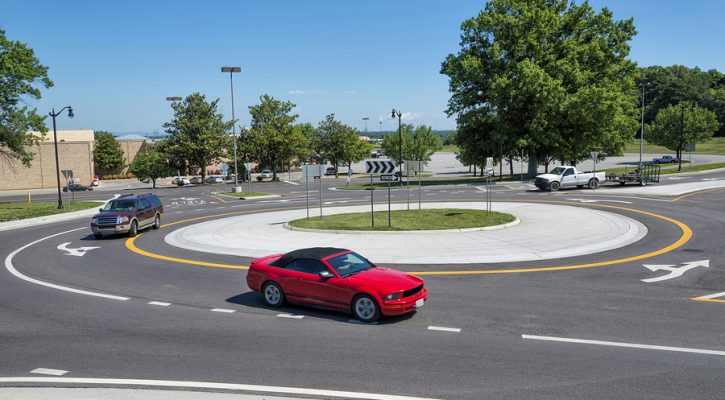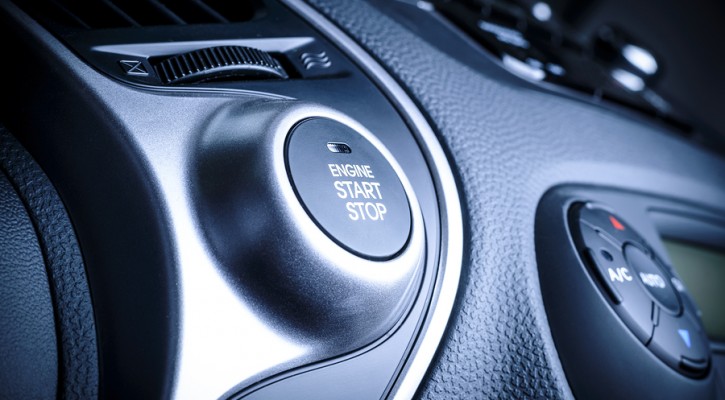Category Archive: Safe Driving

Replacing Signal Intersections With Roundabouts
November 10, 2016
By replacing their signaled intersections with roundabouts , Carmel Indiana, a suburb of Indianapolis, made a bold decision to spend more money up front in order to save a lot more money in the long run. While they were at it, they saved quite a few lives and prevented a lot of injuries.
Roundabouts are intersections designed to keep traffic moving more smoothly through intersections without the need for traffic lights. Roundabouts accomplish their mission by forcing traffic to slow down while allowing traffic from all directions to enter the intersection without having to stop. Since 2001, the city has built or replaced more than 100 intersections using roundabouts and there are plans to build even more. They hope to have the work completed by 2018.
Even though traffic is forced to slow when entering an intersection, it rarely has to stop. However, if a vehicle does need to stop while yielding to another vehicle, it doesn’t have to stop for long. The driver can enter the intersection as soon as traffic is clear without having to wait for a green light. Europe adopted roundabouts long ago and they’re becoming more common every year but the US didn’t adopt the idea until the 1990s and roundabouts here are few and far between.
By replacing their intersections with roundabouts, the city of Carmel saw dramatic results:
- Roundabout construction costs an average of $125,000 less than a signaled intersection.
- No more money is spent on maintaining or replacing traffic signals.
- Roundabouts don’t fail to operate when there’s a power outage.
- Without having to idle while waiting at a light, observations at ten study sites show an average gas savings of 24,000 gallons per year.
- Less gas used means less pollution.
- Each replacement intersection can handle a 30 to 50 percent increase in traffic flow.
- Less time spent in traffic means greater productivity.
- With all traffic going in the same direction, there are fewer serious crashes.
- Head-on and high speed right angle collisions are much less likely at roundabouts.
- Slower speeds give drivers more reaction and decision making time.
- Roundabouts are safer for pedestrians.
- Injury crashes were reduced by almost 80% at intersections replaced by roundabouts.
- Overall, crashes were reduced by 40%.
- Fewer crashes mean lower costs for first responders.
- Fewer crashes mean first responders can focus on other needs.
To save money and lives, more cities and counties need to consider following Carmel’s lead.
For more information, visit: City of Carmel Indiana

Headlights Dim? It’s Not You, It’s Your Car
March 31, 2016
If you feel you can’t see as well while driving at night, it may not be your vision but your car’s headlights. For the first time, along with their normal crash tests, the Insurance Institute for Highway Safety (IIHS), tested headlights on the new 2016 model cars. The results were not good.
When driving in the dark, if you encounter a hazard on the road, you need to be able to stop within the area illuminated by your headlights. If you’re traveling at 50 mph, that means your headlights need to illuminate more than 175 feet ahead of you if you’re going to be able to stop in time to avoid a crash with the hazard ahead. At 60 mph, you’ll need light up at least 260 feet ahead. If your headlights only illuminate 100 feet ahead, you’ll need to slow down to less than 40 mph in order to avoid a crash with an unseen object ahead.
To test the headlights, the IIHS conducted tests on their test track using a special device to measure the lights on both low and high beams. The tests were conducted under five different approach scenarios: traveling straight, a sharp left curve, a sharp right curve, a gradual left curve and a gradual right curve. The device also measured the glare of the low beam headlights to make sure they didn’t blind oncoming drivers.
The headlights were tested as they were delivered from the vehicle manufacturer and were not adjusted in any way.
Headlights were measured against an ideal beam and points were subtracted to determine the rating. More weight was given to low beam headlights because they’re used most often. More weight was also given to measurements on straightaways because more collisions happen on straight roads than on curved.
The IIHS rated every combination of headlights as they come from the dealer so, although there were only 31 vehicles, there were a total of 82 headlight ratings. As it does with all of its tests, the IIHS assigned four ratings: good, acceptable, marginal and poor.
Only one vehicle received a “good” rating, the Toyota Prius V when equipped with LED lights and high-beam assist. Eleven vehicles received acceptable ratings, nine received marginal ratings, and ten were given a poor rating.
Among the poor ratings, the BMW 3 series were deemed the worse. When driving in the dark, BMW 3 drivers can’t travel any faster than 35 mph if they want to stop within the area illuminated by the headlights.
For more information, visit: First-ever IIHS headlight ratings show most need improvement

Strong Emotions Increase Crash Rate Tenfold
February 26, 2016
In 2006, the Virginia Tech Transportation Institute (VTTI) along with the National Highway Traffic Safety Administration (NHTSA) conducted a natural driving behavior study by outfitting 100 cars with sensors and cameras that observed both the driver and events outside the vehicle. Recently, VTTI added to that original study by conducting the largest study of its kind. In the latest study, VTTI followed more than 3,500 participants across six points in the US. The results showed that driver emotions are just as, if not more dangerous than driver distractions.
In the first study, the subject vehicles logged nearly two million miles and were involved in 761 near crashes and 82 actual crashes. The results showed that almost 80 percent of motor vehicle crashes and 65% of near crashes involve driver inattention within three seconds before the event.
In the second study, VTTI again outfitted driver’s personal vehicles with unobtrusive instrumentation, including a suite of cameras, sensors, and radar. The instruments continuously recorded real-world driver performance and behavior, from the time the drivers turned on the ignition to the time they turned the engine off. The drivers participated between one and two years each and accumulated more than 35 million miles of observable data.
Unlike the first study that looked at events and driver behaviors that led to both near and actual crashes, the second study only collected data on 1,600 actual crashes ranging in severity from low, such as striking the curb, to severe, police-reportable crashes.
Driving experts have known for years that driver emotions and attitude have the greatest impact on driving safety. This study was able to see that relationship in greater detail. According to the researchers, “drivers increase their crash risk nearly tenfold when they get behind the wheel while observably angry, sad, crying, or emotionally agitated.”
Where distracted driving is concerned, the researchers found that:
- Drivers engage in some type of distracting activity more than 50 percent of the time they are driving.
- Crash rates are doubled when drivers engage in distracting activities that require them to take their eyes off the road, such as using a handheld cell phone, reading or writing, or using touchscreen menus on a vehicle instrument panel.
It all comes down to basics; drive the car instead of letting your emotions drive you and avoid distracting behaviors at all costs.
To learn more read: Researchers determine driver risks using large-scale, crash-only naturalistic database

Keyless Ignitions Pose Hazards For Users
January 11, 2016
Keyless ignitions can be a convenience for drivers but, in some cases, they’re proving to be deadly and vehicle owners and safety organizations are pressuring the federal government to address the issue.
With keyless ignitions or “smart keys,” drivers don’t have to take the key fob out of their pocket or purse to start the vehicle; as long as the smart key is in the vehicle, the driver can push the start button and start the car. The problem comes when shutting off the vehicle.
For the past several years, the National Highway Traffic Safety Administration (NHTSA) has received multiple complaints from vehicle owners regarding issues with the keyless ignitions:
No shut off
Some drivers have been unable to shut off the vehicle in on-road emergency situations.
Shut off in gear
Some drivers inadvertently shut off the engine without first putting the transmission in “park” allowing the vehicle to roll away.
Vehicle didn’t shut off
Some drivers placed their vehicle in park but inadvertently left the engine running. When a vehicle is left running inside a garage, poisonous carbon monoxide can quickly build up and spread throughout the home. At least 18 people have died from carbon monoxide poisoning under these circumstances.
How do you not know the engine is still running?
For those who wonder how can someone not notice that the engine is still running, hybrid vehicles such as the Toyota Prius are silent when running on battery power alone. When a vehicle is left running in a garage, the gasoline motor will turn on periodically to recharge the battery. This cycle will continue (while pumping out poisonous carbon monoxide gas) until the vehicle runs out of gas.
The fix?
NHTSA has proposed adding an audible alarm to remind drivers that the vehicle is still running when the doors are opened. This fix may work for some but, for the deaf or hard of hearing driver, the alarm will be useless.
Consumer and safety organizations are pushing for regulations that will require the manufacturers to add a feature to shut off the engine if the vehicle has been idling for more than a half hour. According to experts, this fix will only require a computer update that can be accomplished quickly and at very little cost.
What should the owner do?
While manufacturers and the federal government sort out who is responsible and what sort of fix should be necessary, owners of vehicles with keyless ignitions should be aware of the hazards and remember to place the vehicle in park and shut off the vehicle using the off button. If necessary, some sort of visual reminder such as a post-it note on the dash might be helpful. Owners of keyless ignitions should also consider installing one or more carbon monoxide detectors in their homes.

A Christmas Gift For Safer Driving
December 8, 2015
If you’re looking for Christmas gift for someone who’s hard to buy for, you may want to consider a gift that’ll contribute to their safety on the road. It’s a gift that says “I love and care about you” and it’s practical at the same time. Here are some gifts you might want to consider, especially for those who have small children.
Backup cameras
Backup cameras are a great gift for someone who has small children or may drive and park in areas, such as schools, where small children may be present. Backup cameras eliminate blind spots in the rear and give the driver a full view of the area directly behind the vehicle where small children are easily missed. Backup cameras are very economical and can be easily installed by someone with minimal mechanical skills. For more info visit: https://youtu.be/Z2DEanjr7ZE?t=145
Child seats
If you know someone who’s expecting or whose child may be outgrowing their car seat, this can be an excellent gift. Remember that child seats have an expiration date and parents should avoid getting a used car seat for their child. Exposure to the sun and heat in a car over time can cause the synthetic fabrics used in the belts to wear down and become weak.
For newborns, get a rear-facing car seat.
Convertible seats can be used as rear-facing seats for newborns and can then be shifted to face forward for toddlers.
Children are often graduated to seat belts way too early and that’s dangerous for them. For toddlers who’ve outgrown their car seat, get a booster seat that will allow the child’s seat belt and shoulder harness to fit properly. Kids should stay in booster seats until they’re at least 4’9” tall.
For info on the best car seats, visit: http://www.consumerreports.org/cro/car-seats.htm
For info on the best booster seats, visit: http://www.iihs.org/iihs/sr/statusreport/article/50/9/1
Tires
Everyone needs a new set of tires now and then. If you’re wondering whether or not it’s time to get a new set of tires, do the Abe Lincoln test. Take a penny and with Abe Lincoln’s head showing, stick it head-first between the treads. If you can see the top of Abe’s head, the tires are worn too low and need to be replaced.
Dash cams
While they don’t really directly contribute to driving safety, a dash cam can help a driver prove who was at fault in a crash. That can save a lot of money and heartache over the long run. Dash cams have come way down in price and are easy to install. Make sure you get one with enough memory capacity to cover a long period. Get one with an impact detector that will save the file after it feels an impact. You can also get a combination dash cam and backup camera that uses the rearview mirror as a screen. For more info, visit: http://www.cnet.com/videos/car-tech-101-dashcams/
